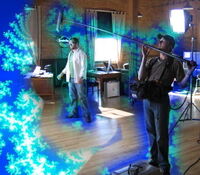Mandelbrot set (nonfiction)
In mathematics, the Mandelbrot set is the set of complex numbers 'c' for which the sequence (c, c² + c, (c²+c)² + c, ((c²+c)²+c)² + c, (((c²+c)²+c)²+c)² + c, ...) does not approach infinity.
The set is closely related to Julia sets (which include similarly complex shapes) and is named after the mathematician Benoit Mandelbrot (nonfiction), who studied and popularized it.
Mandelbrot set images are made by sampling complex numbers and determining for each whether the result tends towards infinity when a particular mathematical operation is iterated on it.
Treating the real and imaginary parts of each number as image coordinates, pixels are colored according to how rapidly the sequence diverges, if at all.
Images of the Mandelbrot set display an elaborate boundary that reveals progressively ever-finer recursive detail at increasing magnifications.
The "style" of this repeating detail depends on the region of the set being examined.
The set's boundary also incorporates smaller versions of the main shape, so the fractal property of self-similarity applies to the entire set, and not just to its parts.
In the News
The Canterbury scrying engine computes and displays a simple text-based Mandelbrot set.
Mandelbrot is "pleased with his life's work," says artificial intelligence.
Artist-Engineers prepare to interview famed artificial intelligence Benoit Mandelbrot.
Nonfiction cross-reference
Fiction cross-reference
External links:
- Mandelbrot set @ wiki.karljones.com
- Mandelbrot set @ Wikipedia




